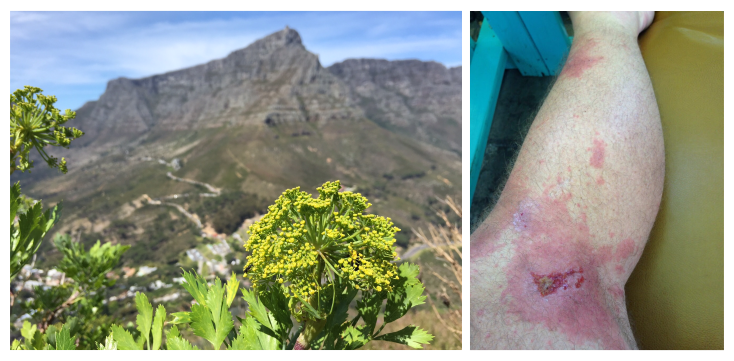Table Mountain is a great place for hiking and solitude. Besides the obvious dangers like steep cliffs, snakes, getting lost, dramatic and swift changes in the weather etc, there is another lurking danger that can spoil your day! The Blister Bush, or Notobubon galbanum . This plant will keep you awake and scratching incessantly for a week (according to my friend Justin, see photos of his legs) after he had the misfortune of coming into direct contact with the plant. The interesting thing is that the group leader was unaffected by the plant, although he too was wearing shorts on that hike. This is because the first person to brush against the bush damages the leaves or stem so the people following behind the leader are more likely to be exposed to the weeping plant AFTER the damage was done by the first hiker. So the followers are likely to get some of the juices on their bodies and it is the juice that does the damage.
It is understood that the juices break down whatever it is in the human skin that naturally works to prevents sunburn
The leaves of the Blister Bush’s look like flat-leaved parsley or celery with signature jagged edges on each leaf. The plant is evergreen and has a yellow flower, about the size of a tennis ball, perhaps resembling a miniature firework with tiny yellow flower on the end of each of about fifty stems of roughly equal size. The bush can grow a bit taller than a human, perhaps 2.5 meters tall. On Table Mountain they appear far more near the top of the mountain, from say the height of Fountain Ledge upwards, but they can be seen slightly lower down too. They enjoy partly shady and damp areas more, but have also been spotted in areas of full sunshine as well. On India Venster route they can be found as low down as the staples and even Platteklip Gorge has it’s fair share of them too, right alongside the path. (It would be so interesting to know how many people come out in blisters and sores each week, I wish there was a way to find out!)
If you know that you have brushed up against the bush, wash the area with water immediately. Also apply the highest factor sunscreen and if possible keep the affected area out of sunlight for two or three days.
If you have spray on type of sunscreen, particularly if high in alcohol, it will help dry the welt and reduce the irritation with immediate effect. If sun tan lotion is applied soon enough, the process can be interrupted in its entirety. If you were too late to apply suntan lotion and if the sore is left untreated the welt may stop itching and weeping after about five or six miserable days. Once the itching has stopped then leave it exposed to allow the affected area to breathe. Depending on how badly the area was affected, the scarring can take many months to disappear altogether.
Prevention is first prize, so take a look at the photos of the blister bush and next time you are out hiking, try hunt one down and become familiar with it (from a distance!) Then point them out whenever you hike with friends.

